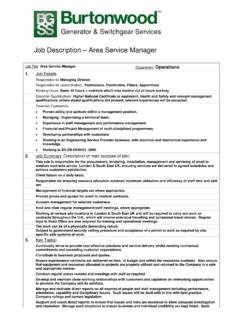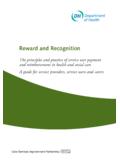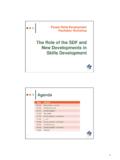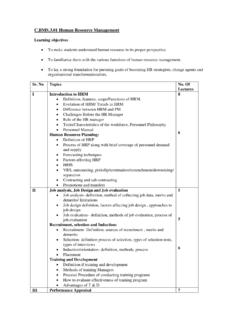Transcription of Call Center Workforce Management Competency …
1 SWPP 2005 1 Call Center Workforce Management Competency definition Outlines Workforce Management The purpose of this document is to provide definition around the Call Center Management Competencies for the Workforce Management domain. Call Center Management professionals pursuing Certification will be required to know and apply the principles upon which these competencies are established. The left hand column lists the Workforce Management competencies; the right hand column provides detail and definition of these competencies. Competency Domain Competency definition outline I. Planning and Strategy 1. Define Workforce Management processes and the role of WFM in the contact Center . Define Workforce Management / Workforce optimization. Describe the implications of overstaffing and understaffing. Identify the contact Center characteristics that make staffing challenges unique.
2 Identify the entities affected by the Workforce Management process. 2. Define the roles and responsibilities required to implement an effective Workforce Management team organizational structure and strategy. Describe the functions associated with Workforce planning. Identify job responsibilities of Workforce professionals. Describe various approaches for organizing Workforce teams. Identify tasks to be completed outside of the team. Develop short-term and long-term personnel budget. Develop performance measures for each role on the WFM team. Develop ongoing development plans for the department and individuals in it. Develop interdepartmental relationships that will position the contact Center as a proactive unit that serves the needs of its internal customers. 3. Identify the tools and technologies that are applicable to the Workforce Management process and when they can be used to good advantage.
3 Identify justification points for automating Workforce Management processes. Evaluate technology options for basic Workforce Management tasks. Evaluate technology options for adjunct Workforce Management tasks. Identify tools to enable simulations and what if scenario analysis. SWPP 2005 2 Identify vendors that supply various Workforce Management /optimization products. 4. Define the data gathering and analysis that serves as the foundation of the forecasting process. List possible sources of planning data. Identify processes for data collection. Describe process for data cleansing and adjustment. Identify business factors that have an impact on call volume/pattern. Describe contact routing options and impact on data collection and forecasting. Describe role of self-service technologies and impact on call data. Describe the process of data collection for non-call contacts.
4 Describe the data sources for outbound call workload. 5. Develop both long-, and short-term forecasts of workload. Define the purpose and process of forecasting. Calculate trend rates using historical data. Identify seasonal factors for monthly forecasts. Describe the impact of special events on the forecast. Identify handle time and incorporate into the forecast of workload. Calculate daily and half-hourly workload patterns. Identify forecasting short-cuts and when to use them. Identify the impacts of cycles and campaigns on the workload forecast. SWPP 2005 3 II. Staffing and Scheduling 1. Describe staffing options and the advantages/disadvantages of each. Describe advantages and disadvantages of in-house staffing. Describe advantages and disadvantages of remote staff alternatives. Describe advantages and disadvantages of outsourcing. Identify the WFM requirements in an environment that uses both in-house and outsourced staffing.
5 2. Calculate staff requirements. Identify the components of staff workload. Calculate staff workload. Define service in terms of speed of answer/speed of response. outline the steps of calculating staff needs for all media. Identify the factors that influence staffing numbers. Determine the impact on service when staff are added or reduced. Explain the effect of size on contact Center efficiencies. Define and calculate staff occupancy/productivity. Describe the relationship between service and cost. Describe the challenges of staffing calculations in skill-based routing environments. Identify the impact of long handle times on both data gathering and staffing calculations. 3. Calculate telephone resources. Identify the components of trunk workload. Calculate trunk workload. Define service goals for blockage and recall. Apply appropriate traffic engineering models for trunk requirements.
6 Describe the relationship between staffing and trunking resources. SWPP 2005 4 4. Create Workforce schedules. Define elements of Workforce shrinkage. Use shrinkage to translate bodies in chairs requirements into schedule requirements. Identify the elements of shrinkage that apply to long-term planning and those that apply to short-term planning. Identify the different perspectives that must be considered in scheduling call Center staff. Identify most likely conflicts in scheduling process. Define the basic components of a work schedule. Define the options of identifying schedule preferences in manual and automated configurations. Identify the impacts of off-phone time requirements such as research, call-backs and help desk environments. Describe benefits/drawbacks of part-time staffing alternatives. Describe benefits/drawbacks of flexible work schedules ( , longer days, different length of day through week, rotations, etc.)
7 Describe schedule optimization techniques. Describe the complications of skill-based scheduling. Identify ways that call Center schedules can be assigned to staff ( , seniority, ranking, performance, preferences, bonus points, bidding, etc.). Describe the implications of team scheduling and other efforts to match staff to supervisors shifts. Identify the implications of the schedule horizon (how long the schedule will be in force). Identify the implications of a union environment on scheduling options. Identify the implications of a shared-seat versus dedicated seat configuration on scheduling options. SWPP 2005 5 5. Identify the WMF planning options in a multi-site contact Center operation. Define multi-site operations including both those that include outsourcers and all in-house configurations. Identify the technologies and techniques that support multi-site contact routing and the implications they have on the forecasting and scheduling processes.
8 Identify alternatives for division of labor and responsibility within a multi-site WFM team. Identify the advantages/disadvantages of centralizing versus decentralizing the forecasting, staff calculation, scheduling and daily tracking processes. Identify the process of follow the sun scheduling. Define the elements of fairness in distribution of schedule choices in a multi-site operation, particularly those spanning several time zones. Define the processes for managing shift trades and time off requests within and across sites. SWPP 2005 6 III. Managing Daily Staffing and Service 1. Identify the elements of Intra-Day Management . Identify the components used to track daily performance. outline the process for intra-day monitoring. Develop the processes for identification of schedule exceptions including minimum length, approval process, submission to WFM team, data entry responsibilities, and tracking.
9 Identify available technologies to assist in intra-day monitoring and how they are used to manage daily service delivery. Identify communications strategies when alterations are required. Identify reaction strategies for both overstaffing and understaffing. Describe methods of managing and optimizing off-phone time. Identify steps to take when service goals are missed. 2. Identify the elements of managing attendance and adherence. Quantify the impact of poor schedule adherence. Identify the impact of missing staff on service, occupancy and cost. Describe options for setting adherence performance goals and selling to the staff. Identify the common reasons for attendance and adherence problems. Describe ways to educate staff on the power of one in contact Center staffing. Identify reward and consequence programs that support adherence goals. outline strategies for addressing the most troublesome attendance problems.
10 Describe negotiation/communication strategies for effective interacting with frontline staff and supervisors. SWPP 2005 7 3. Identify ongoing Workforce Management practices. Identify alternatives for managing vacation and time-off accruals and requests. Identify processes for managing shift trades among staff in both traditional and skill-based configurations. Describe the option for banking time off versus overtime. Identify what if scenario options to be considered to support budgeting and other Management decision processes. Identify processes to support hiring and training planning in all skills required. Identify the process of a mini-bid to accommodate a new hire class. 4. Define reporting and communications processes. Develop real-time reporting process to support intra-day Management . Develop reporting mechanisms for communicating workload trends.




